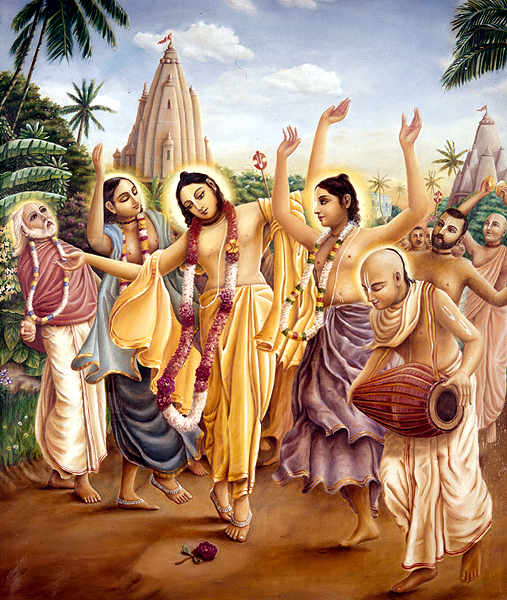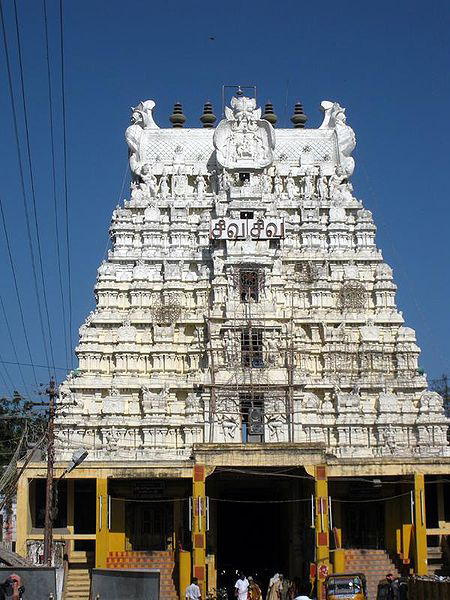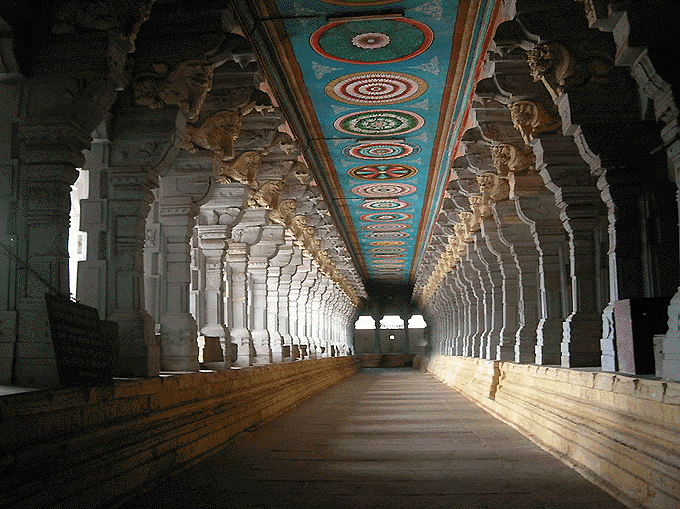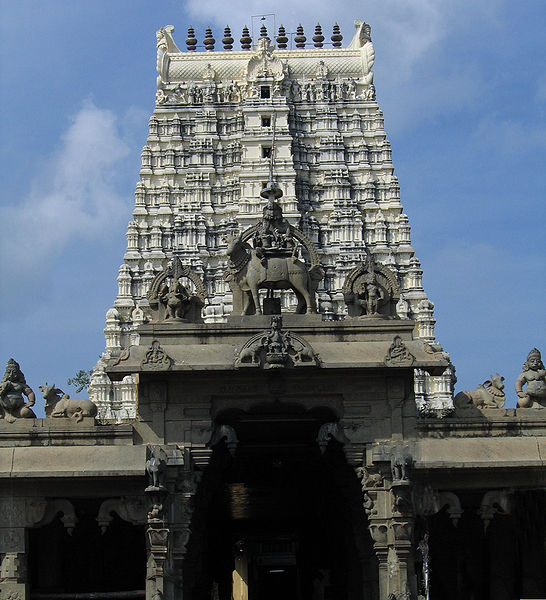
|
|
|
|
BY: SUN STAFF

Lord Caitanya's Sankirtana Party
Jan 27, CANADA (SUN) — A serial exploration of the holy sites visited by Lord Caitanya. Today we begin a new journey, exploring some of the towns and villages, temples, shrines and theerthams visited by Lord Caitanya and his associates during His various travels throughout India. While our segments will not follow the actual progression of the Lord's travels, we hope to cover many of the places that were blessed and purified by having darshan of the Lord and His entourage.
After accepting the sannyasa order, Lord Caitanya traveled through Radha-desa and Santipura, and into Orissa. From there, He made His famous pilgrimage to South India before returning again to Jagannatha Puri. In His later years, the Lord traveled throughout northern India, stopping at many Vaisnava holy sites before retiring again to Puri.
In Caitanya-caritamrta Madhya lila 9, there is an excellent summary given by
Srila Bhaktivinoda Thakura, describing the highlights of Mahaprabhu's travels throughout the south:
"After leaving Vidyanagara, Sri Caitanya Mahaprabhu visited such places of pilgrimage as Gautami-ganga, Mallikarjuna, Ahovala-nrsimha, Siddhavata, Skanda-ksetra, Trimatha, Vrddhakasi, Bauddha-sthana, Tirupati, Tirumala, Pana-nrsimha, Siva-kanci, Visnu-kanci, Trikala-hasti, Vrddhakola, Siyali-bhairavi, Kaveri-tira and Kumbhakarna-kapala.
Finally the Lord went to Sri Ranga-ksetra, where He converted a brahmana named Venkata Bhatta, who, along with his family, became a devotee of Krsna. After leaving Sri Ranga, Caitanya Mahaprabhu reached Rsabha-parvata, where He met Paramananda Puri, who later arrived at Jagannatha Puri. Lord Sri Caitanya Mahaprabhu then proceeded farther, arriving at Setubandha Ramesvara.
At Sri Saila-parvata, the Lord met Lord Siva and his wife Durga in the dress of a brahmana and brahmani. From there He went to Kamakosthi-puri and later arrived at southern Mathura. A brahmana devotee of Lord Ramacandra's talked with Him. Then the Lord took His bath in the river Krtamala. On the hill known as Mahendra-saila, the Lord saw Parasurama. Then the Lord went to Setubandha and took His bath at Dhanus-tirtha.
He also visited Ramesvara, where He collected some papers connected with Sitadevi, whose illusory form was kidnapped by Ravana. The Lord next visited the places known as Pandya-desa, Tamraparni, Naya-tripadi, Ciyadatala, Tila-kanci, Gajendra-moksana, Panagadi, Camtapura, Sri Vaikuntha, Malaya-parvata and Kanya-kumari. The Lord then met the Bhattatharis at Mallara-desa and saved Kala Krsnadasa from their clutches. The Lord also collected the Brahma-samhita, Fifth Chapter, on the banks of the Payasvini River. He then visited Payasvini, Srngavera-puri-matha and Matsya-tirtha. At the village of Udupi He saw the Gopala Deity installed by Sri Madhvacarya. He then defeated the Tattvavadis in sastric conversation.
The Lord next visited Phalgu-tirtha, Tritakupa, Pancapsara, Surparaka and Kolapura. At Sri Rangapuri the Lord received news of Sankararanya's disappearance. He then went to the banks of the Krsnavenva River, where He collected from among the Vaisnava brahmanas a book written by Bilvamangala, Krsna-karnamrta. The Lord then visited Tapti, Mahismati-pura, Narmada-tira and Rsyamuka-parvata. He entered Dandakaranya and liberated the seven palm trees.
From there He visited a place known as Pampa-sarovara and visited Pancavati, Nasika, Brahmagiri and also the source of the Godavari River, Kusavarta. Thus the Lord visited almost all the holy places in South India. He finally returned to Jagannatha Puri by taking the same route, after visiting Vidyanagara again."

Ramesvaram Temple, west gopuram Madhya-lila, 9.199 describes in more detail the Lord's visit to Setubandha (Ramesvara):
"Sri Caitanya Mahaprabhu then went to Setubandha [Ramesvara], where He took His bath at the place called Dhanus-tirtha. From there He visited the Ramesvara temple and then took rest.
PURPORT 
Ramesvaram Temple, pillared corridor As described in Madhya-lila, 9.199, Rameswaram, located in the Ramanathapuram district of Tamil Nadu, is an island that is separated from mainland India by the Pamban channel. It's situated less than 40 kilometeres from the Jaffna Peninsula, Sri Lanka, and is associated with many of Sri Rama's pastimes in Lanka. Devotees in South India consider Rameswaram to be one of the four holiest tirthas, or Char-dhama, and that is not surprising, given that Lord Caitanya Himself visited the place.
The presiding deity of the Rameswara temple is Sri Ramanatha Swamy, a Shiva-lingam that some consider to be one of the twelve Jyotirlingas, although there is some dispute on the matter. While parts of the current temple structure were only erected in the 17th century, the temple visited by Lord Caitanya was originally built in the 12th century, with construction ongoing over a long period of time.
Ramanathaswamy Temple at Rameswara is said to have the largest corridor in India. The pillared corridor has over 1,200 granite pillars, beautifully carved and running a length of nearly 230 meters.
The temple gopuram, east and west, are intricately carved and serve as a stunning example of South Indian architecture for the period. Another interesting feature are the twenty-two wells in the temple complex. The water in each well is said to taste uniquely different than the water in all the other wells.
According to the Puranas, Lord Rama was advised by the rishis to install and worship the Shivalinga here, to expiate the sin of brahmahatya, the killing of a brahmin, being Ravana. Rama fixed an auspicious time for the installation and sent Anjaneya to Mount Kailash to bring back a lingam. Because Anjaneya could not return in time, however, Sita Devi herself made a linga out of sand. When Anjaneya eventually returned with the Kailash linga, called Visvalingam, Lord Rama kindly had it installed alongside the first, and arranged that the Visvalingam should receive worship first.

Ramesvaram Temple, east gopuram
| |